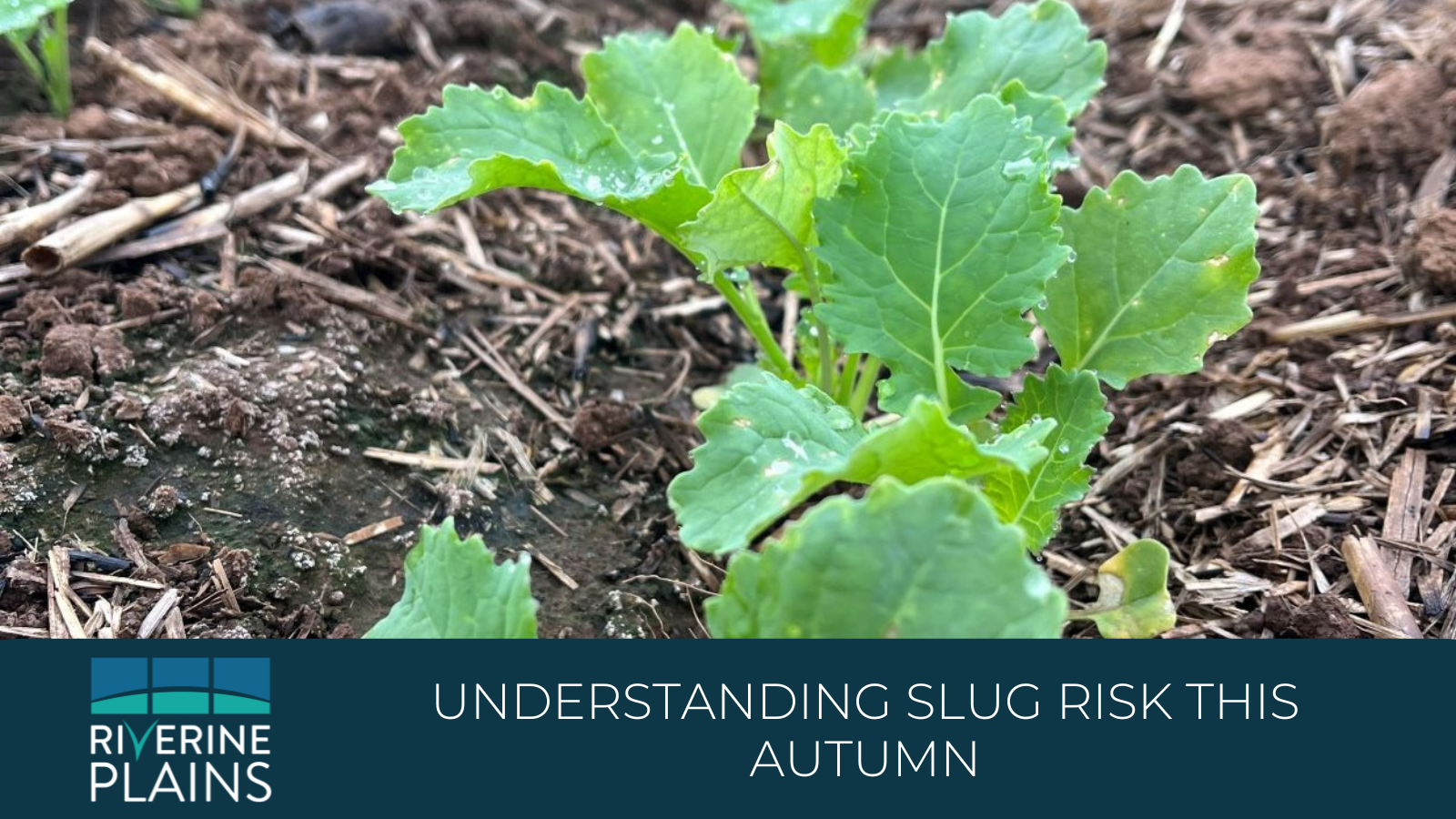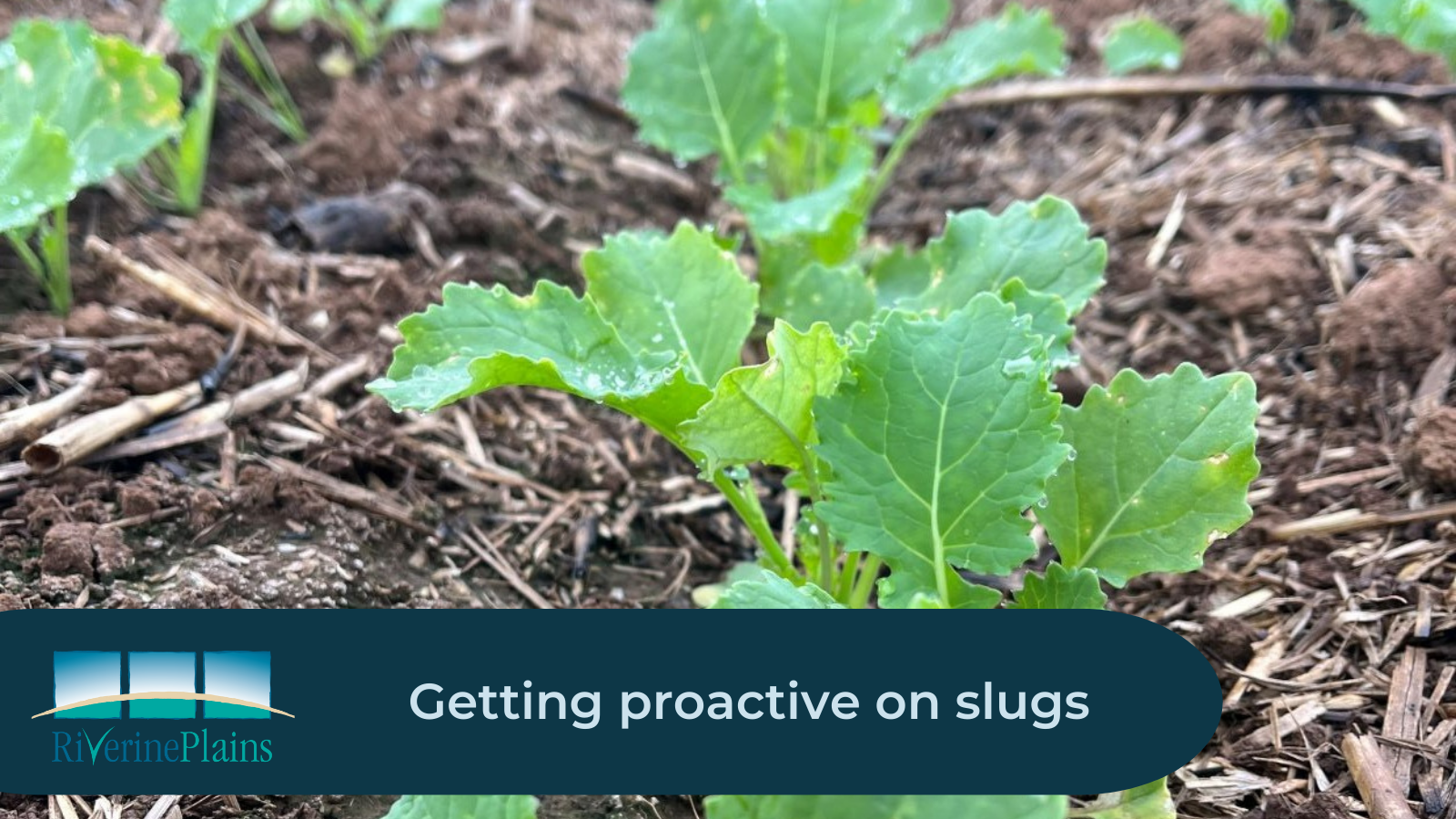Understanding your slug risk this season

Key messages
- seasonal conditions have been conducive to slug survival and population build-up over the past several years
- slug monitoring should start in the spring prior to sowing canola, to better understand the risk
- No one method of control is effective in destroying slug populations and growers should consider a range of control strategies as part of an integrated pest management strategy
Slugs have become a serious establishment pest in the Riverine Plains, with zero and minimum till farming practices, stubble retention and a run of good seasons leading to a build-up in populations.
So, what can farmers do to prevent crop damage to vulnerable crops like canola, and which cultural control options can help reduce the reliance on chemical baits?
What’s the slug risk this season?
The most common slugs in the Riverine Plains are the black keeled slug and the grey field slug, with the brown field slug also present. These species have different behaviours - for more information see the black keeled slugs and grey field slugs PestNotes by CESAR Australia.
Slugs lay eggs when moisture and temperature conditions favour larvae survival. While this generally occurs over winter and spring, it can occur at any time if conditions are right. Good growing conditions and ample soil moisture over the past several years in the Riverine Plains, means slug populations will likely be high heading into sowing.
Given populations as low as one grey field slug per square metre can cause significant damage to canola at establishment, grain growers will need to be prepared to monitor and protect emerging crops. Susceptible crops, such as canola and lupins, are most at risk because they can’t recover from damage to the cotyledons and they are vulnerable as seeds and young seedlings, up to around the six-leaf stage.
Areas at especially high risk include those with an annual rainfall of over 450mm or irrigation, heavy sodic soils, zero-till paddocks, especially with retained stubble, and soils high in clay and organic matter.
When are slugs most active?
Slugs will come to the soil surface when there’s enough moisture across the profile. This is generally after 50-100 mm of rain depending on soil type, but is often staggered (not all slugs within a population will be surface-active at the same time). Slugs are most surface-active when the temperature is 17°C and when there is a minimum of around 20-25% soil moisture. Activity decreases once ground-level air temperature falls below 4°C or increases above 21°C.
Getting a handle on numbers
Growers should ideally start slug monitoring during spring in paddocks that will be sown to canola the following year. However, slugs are mainly active at night, which can make monitoring difficult!
While refuge traps can provide a guide to numbers, it's important to consider that they only provide an estimation of slugs at the surface, and not the total population.
To set a refuge trap, place a mat out overnight or for a few days; slugs will seek refuge under the mat where it is moist and sheltered. When dry sowing, consider that black keeled slug activity may not be detected using surface refuges. This is because they can burrow down to moisture at a depth of 50-60cm and there may not be enough moisture for them to move to the surface.
Farmers can also place a line of bait along a seeding furrow and check for dead slugs after a few days. This should be done before sowing to determine if slugs have emerged. Bait lines will need to be reapplied every two to three weeks.
Slugs move around in moist soil, so it's important to check different areas of the paddock. For this reason, slugs may not be present in a paddock year-on-year and they can also move into new areas.
Using soil moisture probe figures or rainfall data can also help determine the risk by understanding if slugs can physically move from moisture at depth, to the surface.
Cultural controls
Cultural controls are non-chemical methods that are best used as part of an integrated pest management (IPM) strategy.
Choosing a high-vigour variety can reduce the risk of slug damage when sowing canola. For example, a high vigour GM variety is less susceptible than triazine tolerant (TT) varieties, which establish more slowly.
Similarly, vigour can be improved by sowing earlier when soil temperatures are warmer; this can help canola emerge and establish more quickly.
Increasing seeding rates can also improve establishment rates of susceptible crops, especially in paddocks where slugs have been identified the previous spring.
An effective summer weed control program that removes vegetation cover, food and shelter for slugs, will also reduce the risk of damage.
Soil clods provide shelter for slugs on the surface and strategic cultivating before sowing or rolling post-sowing can help destroy slug habitats. However, this may not fit with zero or reduced till operations, so assess the severity of the problem and make a decision that fits the system.
The addition of gypsum to poorly structured soils will improve conditions in the root zone, aiding root growth and allowing plants to establish more quickly.
Natural predators of slugs include spiders, earwigs, free-living flatworms, rove and carabid beetles and ciliate protozoa (a natural parasite of slugs and snails found in Australia), as well as frogs and birds. While these play a valuable role, they are unlikely to reduce populations below damaging thresholds.
Chemical control
Metaldehyde and iron-based baits are registered for slug control in Australian broadacre crops.
To ensure your baiting program is effective, consider slug activity levels, attractiveness of bait and number of pellets per unit area, as well as palatability.
Pick your bait according to the conditions. A smaller bait will have larger surface area, which improves the chance of encounter, however, they also break down more quickly, especially after rain. Expensive baits are more rain-fast, so may be worth the extra money.
The best time to bait is generally after sowing and before crop emergence. This will kill slugs before they can cause damage to emerging seedlings.
Slug emergence can be staggered, so continue to monitor, especially after rainfall, and re-bait if required.
Tips for baiting:
- don’t mix bait with fertiliser in the spreader as they have different densities and don’t spread evenly
- ensure the spreader is calibrated correctly to prevent over and under-baiting
- ensure enough moisture for bait to swell and release its active ingredient
- avoid applying bait before rain as the active will wash off
- apply bait after rain to target a greater proportion of the slug population
An integrated approach
No single method provides a complete control over slug populations. Therefore, farmers need to adopt a range of strategies using integrated pest management (IPM) approach combining aspects of chemical, cultural and biological control.
Riverine Plains has recently commenced a new project Optimising Slug Management which aims to investigate best practice to reduce slug damage in canola using chemical and non-chemical options.
For further information about this project, please contact Riverine Plains Senior Project Officer Kate Coffey by emailing kate@riverineplains.org.au
References and further reading
From the Ground Up, Slugs and no till (Vic No-till hardcopy publication)
Slug control, identification and management (GRDC)
Grey field slug (CESAR Australia)
Black keeled slug (CESAR Australia)
Slug baiting for integrated control (PIRSA)
Getting proactive on slugs – Riverine Plains blog


